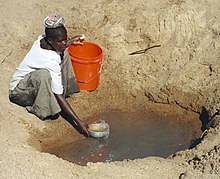
The main causes of water scarcity in Africa are physical and economic water scarcity, rapid population growth, and the effects of climate change on the water cycle. Water scarcity is the lack of fresh water resources to meet the standard water demand.[1] The rainfall in sub-Saharan Africa is highly seasonal and unevenly distributed, leading to frequent floods and droughts.[2]

The Food and Agriculture Organization of the United Nations reported in 2012 that growing water scarcity is now one of the leading challenges for sustainable development.[3] This is because an increasing number of river basins have reached conditions of water scarcity. The reasons for this are the combined demands of agriculture and other sectors. Water scarcity in Africa has several impacts. They range from health, particularly affecting women and children, to education, agricultural productivity and sustainable development. It can also lead to more water conflicts.
To adequately address the issue of water scarcity in Africa, the United Nations Economic Commission for Africa emphasizes the need to invest in the development of Africa's potential water resources. This would improve food security and water security, and protect economic gains by effectively managing droughts, floods, and desertification.[4]
- ^ "Water Scarcity | Threats | WWF". World Wildlife Fund. Retrieved 2020-11-29.
- ^ "International Decade for Action: Water for Life 2005-2015". Retrieved 1 April 2013.
- ^ FAO (2012). Coping with water scarcity - An action framework for agriculture and food security, FAO Rome.
- ^ "Management Options to Enhance Survival and Growth" (PDF). Archived from the original (PDF) on 7 May 2020. Retrieved 18 March 2012.